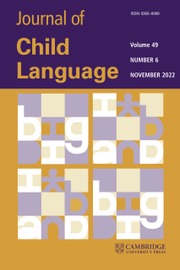Article contents
The mosaic acquisition of grammatical relations*
Published online by Cambridge University Press: 17 February 2009
Abstract
The view that grammatical relations have substantial essence, designated as ‘subject’ or ‘object’ has difficulty in accounting for the variety of naturally acquirable grammatical relations. The acquisition of grammatical relations is examined from a theoretical framework, ROLE AND REFERENCE GRAMMAR, in which grammatical relations are decomposed into two separate types of structure: logical (semantic) structure and information (pragmatic) structure. The acquisition of grammatical relations from four languages is compared: (1) the definite accusative suffix and pragmatically motivated word order of Turkish; (2) Kaluli verb agreement, case and focus marking postpositions, and pragmatically motivated word order; (3) Hungarian definite and indefinite verb conjunction; and (4) Italian participial agreement and anaphoric, accusative case pronouns. Two conditions on structures are found to cause difficulty: the neutralization of a semantic or pragmatic distinction by interfering structures (e.g. Kaluli and Italian), and global case marking which forces the child to discover relevant semantic characteristics of both the actor and the undergoer (e.g. Hungarian and Kaluli). Structures that encode semantic or pragmatic distinctions independently are more easily acquired (e.g. Turkish). Piecing together discrete structures in a mosaic fashion, the child can acquire the great variety of grammatical relations that exist in human languages.
Information
- Type
- Articles
- Information
- Copyright
- Copyright © Cambridge University Press 1991
Footnotes
The author thanks Patricia Clancy, Dan Slobin, Ceil Toupin, and Robert Van Valin for their helpful comments and criticisms. The author also thanks Betty Hart and the Juniper Gardens Language Project for help in preparing this paper.
References
REFERENCES
- 22
- Cited by

